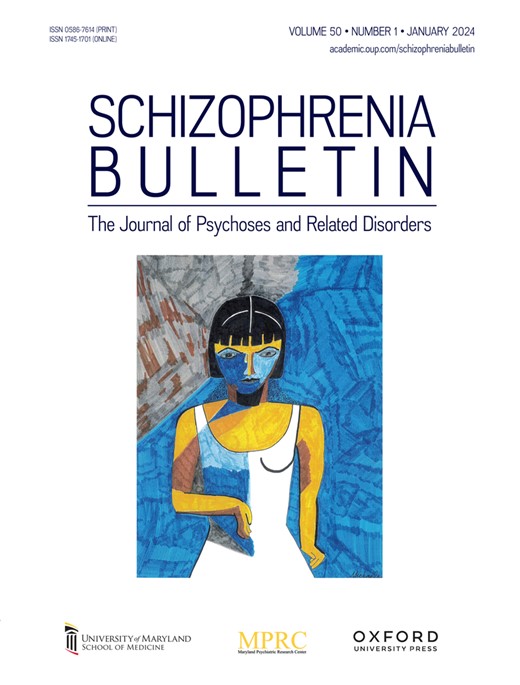视网膜年龄差距作为精神分裂症早期进程中加速衰老的标志
IF 4.8
1区 医学
Q1 PSYCHIATRY
引用次数: 0
摘要
背景与假设鉴于已有的研究结果证实精神分裂症(SZ)的大脑衰老加速,我们进行了一项旨在验证定量视网膜形态学数据是否能够预测年龄以及精神分裂症患者是否存在视网膜年龄差距(RAG)阳性的研究。研究设计纳入两组患者和对照组:一组包括59例SZ患者和60例对照,所有患者均接受光学相干断层扫描(OCT),测量72个变量。第二个样本由65名SZ患者和70名对照者组成,然后与第一个样本相结合,生成一个数据库,其中每个受试者由28个形态学变量代表。使用四种不同的机器学习(ML)算法进行基于z标准化OCT数据的年龄预测。还分析了RAG、人口统计学和临床数据之间的关系。研究结果两种样本的患者视网膜年龄和阳性RAG均明显较高,根据具体样本的不同,年龄在5.88至7.44岁之间。基于较大群体但较少OCT变量的预测显示出较高的预测相对误差。关于视网膜年龄,所有ML算法都产生了相似的结果。RAG与抗精神病药物剂量和症状严重程度相关。与实足年龄的相关性表明,RAG在年轻患者中最高,从45岁左右开始下降。结论基于ml的结果证实了精神分裂症患者视网膜衰老加速,并显示其与药物治疗和综合征严重程度相关。在年轻患者中发现更大的RAG是新的,需要复制。本文章由计算机程序翻译,如有差异,请以英文原文为准。
The Retinal Age Gap as a Marker of Accelerated Aging in the Early Course of Schizophrenia
Background and Hypothesis Given the available findings confirming accelerated brain aging in schizophrenia (SZ), we conducted a study aimed at verifying whether quantitative retinal morphological data enable age prediction and whether schizophrenia patients present with a positive retinal age gap (RAG). Study Design Two samples of patients and controls were enrolled: one included 59 SZ patients and 60 controls, all of whom underwent optical coherence tomography (OCT) enabling the measurement of 72 variables. A second sample of 65 SZ patients and 70 controls was then combined with the first sample, to generate a database where each subject was represented by 28 morphological variables. Four different machine learning (ML) algorithms were used for age prediction based on z-standardized OCT data. The associations between RAG, demographic, and clinical data were also analyzed. Study Results Patients from both samples had significantly higher retinal age and positive RAG ranging between 5.88 and 7.44 years depending on the specific sample. Predictions based on the larger group but with fewer OCT variables exhibited higher prediction relative error. All ML algorithms generated similar outcomes regarding retinal age. RAG correlated with the dose of antipsychotic medication and the severity of symptoms. Correlations with chronological age showed that RAG was the highest in younger patients, and from the age of about 45 years, it decreased. Conclusions ML-based results corroborated accelerated retinal aging in schizophrenia and showed its associations with pharmacological treatment and syndrome severity. The finding of a larger RAG in younger patients is novel and requires replication.
求助全文
通过发布文献求助,成功后即可免费获取论文全文。
去求助
来源期刊

Schizophrenia Bulletin
医学-精神病学
CiteScore
11.40
自引率
6.10%
发文量
163
审稿时长
4-8 weeks
期刊介绍:
Schizophrenia Bulletin seeks to review recent developments and empirically based hypotheses regarding the etiology and treatment of schizophrenia. We view the field as broad and deep, and will publish new knowledge ranging from the molecular basis to social and cultural factors. We will give new emphasis to translational reports which simultaneously highlight basic neurobiological mechanisms and clinical manifestations. Some of the Bulletin content is invited as special features or manuscripts organized as a theme by special guest editors. Most pages of the Bulletin are devoted to unsolicited manuscripts of high quality that report original data or where we can provide a special venue for a major study or workshop report. Supplement issues are sometimes provided for manuscripts reporting from a recent conference.
 求助内容:
求助内容: 应助结果提醒方式:
应助结果提醒方式:


